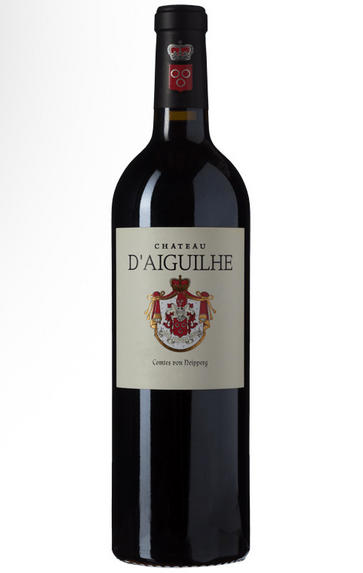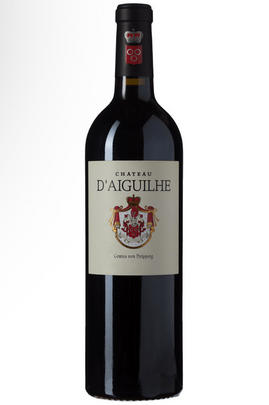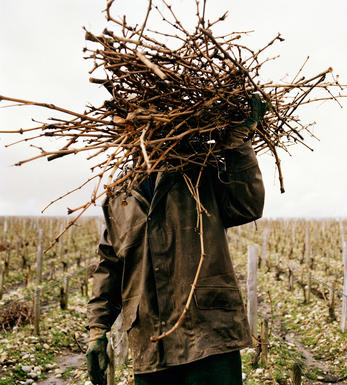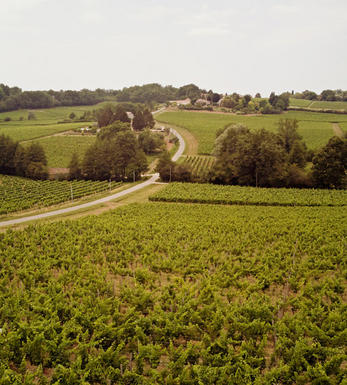
2016 Château d'Aiguilhe, Côtes de Castillon, Bordeaux

Critics reviews
Neal Martin - 28/04/2017
About this WINE

Chateau d'Aiguilhe
Chateau d'Aiguilhe is a very old holding located on a rocky aiguille (French for "needle" or "peak") in the Cotes de Castillon region. The peak was once used by the Knights Templar as a stronghold with the present chateau dating back to the 13th century.
D'Aiguilhe is owned by Stephan von Neipperg who also owns several Saint-Emilion properties including Château Canon-La-Gaffelière, Clos de l'Oratoire, Chateau Peyreau and La Mondotte.
D'Aiguilhe's vineyards are planted on the upper southern (sun facing) slopes, giving them excellent drainage and thin soils over a limestone base. The wine maker is Jean-Patrick Meyrignac who has a flexible approach for gaining the best from the low yields of each vintage.

Côtes de Castillon
To the east of the St Émilion wine appellation, and on the north bank of the Dordogne, Côtes de Castillon has been the site of considerable interest and investment since the early 2000s. Wine production is significant, yielding over 1.5 million cases per annum and quality is quite variable, ranging from the everyday from the sandy and light gravel soils to imposing, aspirational wines benefiting from considerable investment, and made from the clay and limestone vineyards on higher slopes.
The style of these latter wines is akin to good St Émilion, and the wines use predominantly Merlot and Cabernet Sauvignon. In common with other regions recognised to produce interesting and good-value wines, several well-known St Émilion proprietors have invested in the appellation over the past decade, among them Gérard Perse of Ch. Pavie, Stephan Von Neipperg of Canon-la-Gaffelière, and consultant Stéphane Derénoncourt.

Cabernet Sauvignon Blend
Cabernet Sauvignon lends itself particularly well in blends with Merlot. This is actually the archetypal Bordeaux blend, though in different proportions in the sub-regions and sometimes topped up with Cabernet Franc, Malbec, and Petit Verdot.
In the Médoc and Graves the percentage of Cabernet Sauvignon in the blend can range from 95% (Mouton-Rothschild) to as low as 40%. It is particularly suited to the dry, warm, free- draining, gravel-rich soils and is responsible for the redolent cassis characteristics as well as the depth of colour, tannic structure and pronounced acidity of Médoc wines. However 100% Cabernet Sauvignon wines can be slightly hollow-tasting in the middle palate and Merlot with its generous, fleshy fruit flavours acts as a perfect foil by filling in this cavity.
In St-Emilion and Pomerol, the blends are Merlot dominated as Cabernet Sauvignon can struggle to ripen there - when it is included, it adds structure and body to the wine. Sassicaia is the most famous Bordeaux blend in Italy and has spawned many imitations, whereby the blend is now firmly established in the New World and particularly in California and Australia.


Buying options
Add to wishlist
Description
The 2016 Chateau d'Aiguilhe is a blend of 85% Merlot and 15% Cabernet Franc picked from 30 September until 18 October, matured in 30% new oak. It has a warm and sensual bouquet: small macerated black cherries, blueberry and sloes, a light floral tincture emerging with time. This has a little more strictness compared to the 2015 last year. The palate is medium-bodied with fine tannin and good body. Sappy black fruit, a touch of spice towards the finish, and you have yourself a very fine Ctes de Castillon.
Neal Martin - 28/04/2017
wine at a glance
Delivery and quality guarantee